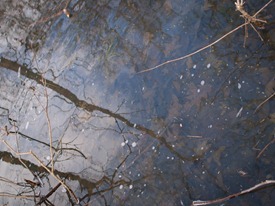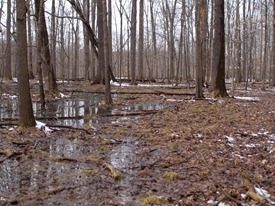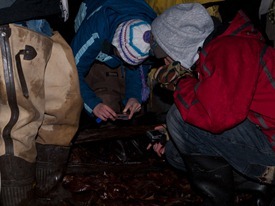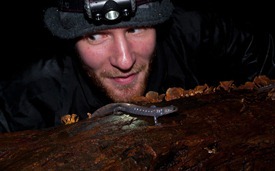Exploring the vernal pool we generally observe mole salamanders in during the day didn’t yield any salamanders, but it was interesting to see countless spermatophores left over from the previous night’s activity.
 |
 |
One point of interest that came up during the salamander hunt on Wednesday night was the variation in spotted salamander coloration. Not much hybridization occurs with spotted salamanders (at least not as much as in the Jefferson complex), but this variation could conceivably result from hybridization. I wonder what environmental conditions could cause spot variation. Presumably, spots serve to warn potential predators of a distasteful and possibly toxic prey source, so with lots of natural variation occurring, it’d be a bit easier to test predation-risk as a function of the number or prominence of yellow spots.
Anyway… here’s a couple of spotted salamander photos illustrating some spot variation, Dean’s first encounter, and a spermatophore!
 |
 |
Some of what-might-be unisexual Ambystoma that we encountered Wednesday appeared more like Jefferson Salamanders, having limited blue spots and long toes on their hind feet. Interestingly, there was one Jefferson Salamander with six toes on its hind, right foot, which makes at least one malformed amphibian caught during every trip I’ve been to this vernal pool!
A couple of years ago during the annual salamander outing, a flip of a log yielded a mole salamander with blue speckles. At the time, I didn’t look into it much – I was aware that it could be a blue-spotted salamander, Jefferson salamander, or a weird hybrid complex that consists of parthenogenic uni-sexual Ambystoma spp. This past Wednesday night, however, we found much more than the one, obscure amphibian under a log, possibly because the trip occurred earlier in the year (there’s still ice on the pool), and Jefferson salamanders are known to migrate over the snow to their breeding ponds.
According to Michael Lannoo’s book, Amphibian Declines, blue-spotted salamander populations are extremely limited in their Ohio distribution. Rather, Ambystoma laterale occurs commonly north of Ohio, in Michigan and New York, but is only recorded in one or two counties in Ohio. In contrast, a hybrid complex, often containing part of the A. laterale and A. jeffersonianum genome, is common in northern Ohio counties, and I think we encountered this bizarre uni-sexual hybrid! I don’t believe any males were found, and there was considerable variation in the amount of speckling along the sizes, legs and backs of the salamanders. The hybrid is known to make annual migrations to vernal pools to reproduce and is visually indistinguishable from blue-spotted and often Jefferson salamanders.
 |
 |